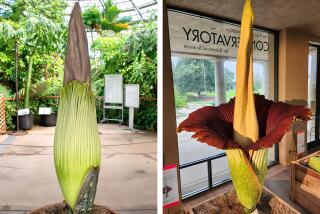As a twig is bent, so grows the art of bonsai
The Bonsai-a-Thon at the Huntington had barely gotten underway Saturday morning, but Alex Marien had already dropped nearly $200 on pots and plants.
“It’s an expensive hobby,” said Marien, an engineer who lives in Upland and planned to spend the entire day in San Marino with his wife, Hedy, watching demonstrations by bonsai practitioners and browsing the bonsai bazaar, with its stacks of how-to books, hand-thrown pots and lethal-looking branch benders, shears and trunk splitters.
The Mariens were among more than 5,000 visitors who poured through the gates of the Huntington Library, Art Collections and Botanical Gardens on a dazzlingly sunny day to watch lion dancers and musicians noisily usher in the lunar Chinese new year and to marvel at pink and white blossoms that had burst from trees throughout the grounds, harbingers of an early spring.
Away from the clanging cymbals and banging drums, hundreds of the visitors made a beeline to the Huntington’s Botanical Center to view displays of bonsai masterpiece trees and to watch local masters share their techniques. The event was part of a two-day fundraiser, continuing today, supporting the Golden State Bonsai Federation collection at the Huntington.
Bonsai (pronounced bone-sigh) is the ancient art of blending horticulture and imagination to create miniature plants that look like they would in nature. Through many years of painstaking pruning, bonsai artists train pines, junipers, hornbeams and other plants grown in pots to resemble old objects from forests and mountains.
“It takes on average five years to get [a] tree appropriate for a show,” said Ted Matson of Pasadena, regarded as one of Southern California’s finest practitioners. “It’s the kind of art form where the breadth and depth of experience available to one is pretty limitless. Once you embark, you really do embark on a lifelong path of learning.”
More than 1,500 years ago in China, early practitioners began collecting from mountainsides old trees with grotesquely twisted trunks and cultivating them in pots. The tradition came to be called penjing. A few hundred years later, the Japanese took up the practice, with creations that emphasized the harmony between people and nature. They called their form bonsai, and it is today far more influential than the Chinese style.
Bonsai has grown in popularity, with a diverse following that includes men and women, young and old, from all over the world. California has more than 5,000 practitioners in 72 clubs.
Juan Morales and Felipe Rodriguez, two bonsai enthusiasts from Tijuana, watched as Mel Ikeda, a former hair stylist, used familiar snipping techniques to shape three young junipers and wire their branches until they began to resemble a perfect miniature forest. He planned to add moss to give the new trees the aura of age.
“The bonsai is all about time,” said Ikeda, who lives in Costa Mesa. “You see the tree, you see the man and you see the two come together.”
*



